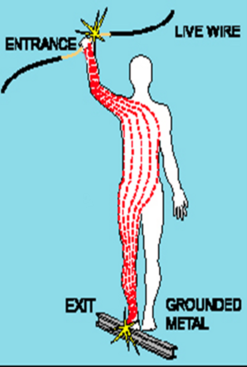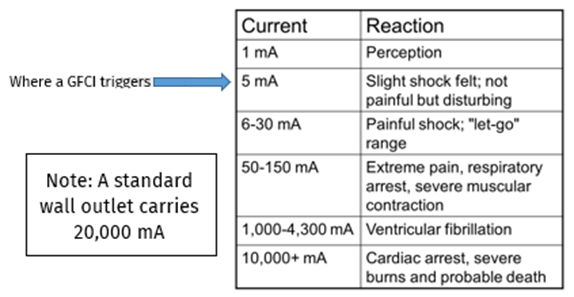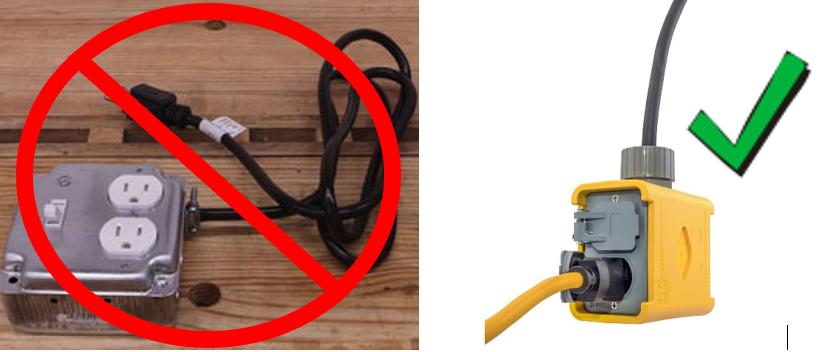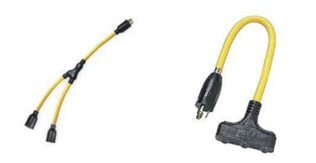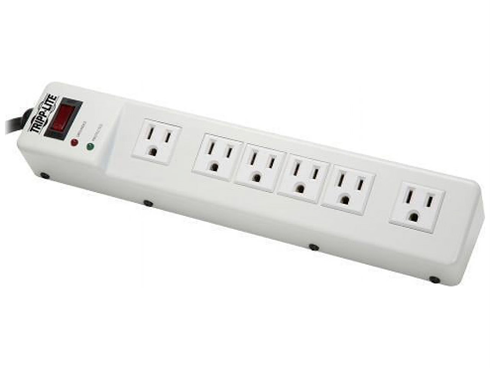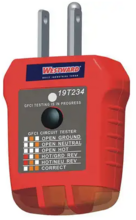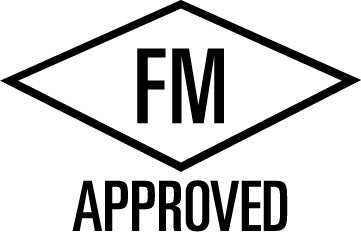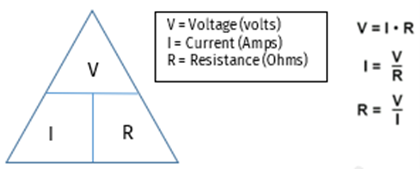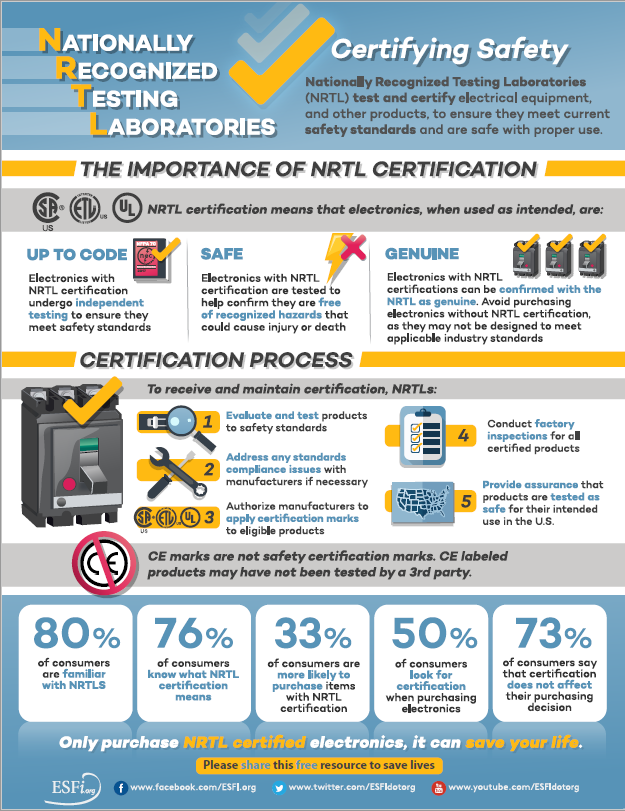Basic Electrical Safety
-
Purpose
The University of California, Riverside (UCR) Basic Electrical Safety Program is designed to protect employees from hazards such as electric shock, burns, fires, and explosions.
This program provides guidance for identifying electrical hazards and establishing effective controls to prevent injuries and property damage.
-
Scope
This program applies to all UCR employees who work with electrical equipment which may expose them to electrical hazards from systems, equipment, or tools operating at up to 208 volts.
Adjustment, maintenance, and repair on systems or equipment with exposed energized hazards above 50 volts is prohibited unless the employee has the necessary training, experience, can perform the work safely, and supervisor authorization.
This program does not cover electrical work which includes adjustment, maintenance, or repair work on systems and equipment operating at over 50 volts. Those activities will be addressed under the UCR Advanced Electrical Safety Program (under development). Researchers should refer to the Research Electrical Safety Program and coordinate with the Research Safety Engineer. Non-researchers and maintenance groups should contact the Campus Safety Engineer for guidance.
-
Responsibilities
The goal of the UCR Basic Electrical Safety Program is to ensure that all employees understand the hazards associated with electrical energy and are capable of performing the necessary steps to protect themselves and their coworkers. Responsibilities include:
Staff and Students
- Be aware of electrical safety hazards.
- Comply with safe operating procedures and this program when using electrical equipment.
- Complete safety training as assigned.
- Work within your training and authorization level.
- Inspect all electrical equipment prior to plugging in and using.
- Report safety concerns including damaged cords, burning, smoke, fire, etc. to your supervisor and EH&S immediately.
Managers and supervisors
- Ensure staff have the necessary experience, skill, training, before authorizing them to work on electrical equipment.
- Document authorization for personnel and include the scope of electrical work and tasks allowed.
- Conduct periodic hazard analysis of work areas to identify electrical safety hazards.
- Correct identified safety hazards.
- Develop standard operating procedures (SOPs) or other safe work procedures for all electrical systems and equipment.
- Use Lockout/tagout to prevent personnel from exposure to live parts or broken equipment.
- Consult with the appropriate maintenance service group as needed to ensure the building electrical infrastructure is protected, your connections are safe, and that you will avoid impacting other building occupants.
- Never allow or attempt to access electrical panels, or rooms without specific approval from EH&S or the appropriate maintenance service group electrical supervisor.
- Never allow or attempt to modify or alter any building electrical system or any of its components including disconnects, breakers, switches, outlets, and lighting fixtures.
- Report safety concerns including damaged cords, burning, smoke, fire, etc. to EH&S.
Maintenance Services Group Supervisors (Facilities Services, Auxiliary, etc.)
- Ensure that all authorized or qualified maintenance personnel have received appropriate levels of training.
- Ensure appropriate personal protective equipment (PPE) is provided to authorized or qualified staff who work with electrical equipment.
- Ensure all infrastructure electrical equipment is safe and does not have exposed electrical conductors, open junction boxes, open punchouts in boxes, missing plate covers, open panel faces, etc.
- Restrict access to all electrical rooms and panels throughout buildings for non-maintenance persons unless specific approval has been granted by the electrical supervisor or EH&S.
- Ensure all damaged or unsafe electrical equipment is locked out in accordance with the UCR Hazardous Energies and Lockout/Tagout Program.
- Lockout electrical systems and equipment for non-authorized employees as the responsible individual to allow them to adjust, maintain, and repair equipment safely.
- Report safety concerns including damaged cords, burning, smoke, fire, etc. to EH&S.
Environmental Health & Safety (EH&S)
- Consult on electrical safety issues
- Assist in electrical hazard assessments and developing electrical hazard controls
- Provide information regarding online and in-person electrical safety training options.
- Report all electrical fires, battery thermal incidents, burnt cords or outlets, or smoking equipment to Office of the State Fire Marshal (OSFM) per mandate
- Review developed electrical equipment safe operating procedures (SOPs), as requested or necessary.
- Assess electrical systems and equipment to ensure they are compliant, safe for the intended use, and maintained in a safe usable condition.
- Oversee a 3rd-party approval process for electrical equipment that is not approved by a nationally recognized testing lab (NRTL) as required by the OSFM and Cal/OSHA.
- Be aware of electrical safety hazards.
-
Electricity on Campus
All employees use electrically powered equipment and systems throughout the campus. Whether in an office, lab, kitchen, dormitory, or workshop, electricity is used continuously, usually without incident. Electricity behaves the same no matter what country you are in. It doesn’t matter whether you are an electrician, a researcher, an engineer, or an office worker. If you contact a hazardous live circuit part, your life will be at risk. In this sense, mere compliance to local national regulations matters less than understanding basic electrical safety principles.
In general, campus provides 120-volt 20-amp outlets throughout most buildings. Where required 208-volt or higher power may be available for equipment in places like workshops, labs, and non-public utility rooms. Requests for specific electrical supply should be directed to the appropriate maintenance service group for your building.
-
Electricity is Dangerous
Even voltages as low as 12 volts can be dangerous—but what does that really mean? Electricity is the movement of electrically charged atoms, or electrons, flowing in one direction from positive to negative (or to ground). When working with or near electrical equipment, a person may accidentally become part of an electrical circuit. If this happens, electricity can pass through the body, generating heat due to the body’s natural resistance. This can result in severe burns, and the electrical current can also disrupt the body’s normal electrical signals, potentially causing cardiac or respiratory arrest.
Only trained, authorized, or qualified individuals are permitted to repair or service electrical equipment. However, even regular users of electrical devices and batteries can be at risk when equipment, outlets, or cords are damaged, uncovered, or have exposed wires.
As part of the Injury and Illness Prevention Program, departments must conduct workplace hazard analyses and periodic safety inspections to identify and correct these issues. This hazard assessment helps each work unit define specific electrical hazards, develop mitigation plans, and provide appropriate employee training.
-
When is Electricity Considered Hazardous and What are the Consequences?
Electricity poses hazards to human health and safety in three main ways: electric shock, arc flash, and arc blast. There are also thermal hazards that can cause serious burn injuries. According to OSHA and NFPA 70E, electrical systems with voltages of 50 volts AC or higher are considered hazardous. Other types of electrical (DC, RF, batteries , etc.) have their own thresholds as well.
At UCR, employees may encounter a range of complex electrical hazards. To address this, UCR has adopted specific hazard thresholds that align with major electrical safety standards. Any circuit powered by a source rated above the established threshold is considered extremely hazardous and requires extreme caution and advanced training.
Without the required training and authorization, personnel are not permitted to perform electrical work on systems exceeding these thresholds. When shock or arc flash hazards are identified, only maintenance service group electricians or qualified contractors may perform the work.
If you are uncertain about what electrical work you are authorized to perform, contact EH&S Safety for guidance and consultation.
Shock Hazard Thresholds
Electrical Shock
Electricity is one of the most common hazards in any facility. Under normal conditions, built-in safety features (engineering controls) protect workers from shock. Electrical shock occurs when electrical current flows through any part of a person’s body from an external source. Such incidents can result in serious injury or death.
When a person contacts an energized (ungrounded) conductor while also touching a grounded object, an alternate path to ground is created, allowing current to pass through the body. The electrical current may make use nerve pathways, muscle tissue, or even blood vessels as it makes it way to the negative or grounded connection point. The most dangerous pathway is one where the current can pass through the chest and heart. The different types of electricity (AC. DC, RF, etc.) will have differing effects but all can cause significant damage internally. Current is measured in amperes (A) but can be extremely dangerous even in the milliampere (mA) range.
- The effects of electric current on the human body depend on several variables, including:
- Amount of current
- Waveform of the current (e.g., DC, 60 Hz AC, RF, impulse)
- Pathway of the current through the body (determined by contact points and internal body chemistry)
- Duration of exposure
- Amount of energy deposited into the body
- The amount of current that flows through the body depends on:
- Voltage driving the current
- Circuit characteristics (impedance, stored energy)
- Frequency of the current
- Contact resistance and the body’s internal resistance
- Environmental factors affecting contact resistance
- Voltage driving the current
- The heart and brain are the organs most vulnerable to electric shock. Fatal ventricular fibrillation—a disruption of the heart’s normal rhythm—can be triggered by currents as low as 70 mA. Without immediate resuscitation, shock can cause death by cardiac arrest, respiratory paralysis, or complete heart stoppage.
- Severe internal burns may also occur, even if the current does not pass-through vital organs. Because physiological responses vary among individuals, exact voltage or current thresholds for injury cannot be precisely defined.
- Anyone who experiences an electrical shock should receive immediate medical evaluation, even if no visible injuries are apparent. Internal damage and burns may not be immediately detectable.
AC Power Response
Alternating current (AC)—typically at 60 hertz (Hz)—is particularly dangerous. Exposure to AC at these frequencies can induce ventricular fibrillation at low thresholds and cause severe muscle contractions, potentially leading to a no-let-go situation where the victim cannot release the conductor.
DC Power Response
Direct current (DC) can also cause muscle contractions during contact and release, and prolonged exposure can lead to heart fatigue or failure at high current levels. DC does not usually cause muscle paralysis or no-let-go hazards at low currents but can still be fatal due to internal tissue burning over time.
Radio Frequency Response
Radiofrequency waveforms (5 kHz – 100 MHz) cause decreasing neurological effects as frequency increases, but deposited energy can result in tissue burns.
Capacitor response
Capacitors store electrical energy and can retain a dangerous charge even after being disconnected. An impulse shock can occur if discharged through the body. Damage depends on voltage, total stored energy, and discharge time. High-energy discharges can trigger fibrillation, while lower voltages usually discharge more slowly due to skin resistance, reducing risk.
High Voltages
For voltages above 600 V, an additional hazard exists: the potential for arcing through air gaps. Contact is not necessary for injury. Safe approach distances and proper enclosures must be maintained to prevent exposure.
At UCR, high-voltage work is prohibited without specific EH&S written approval.
Battery Hazards
Work involving batteries or battery banks presents both electrical and physical hazards. Flooded lead-acid batteries also pose chemical and explosion risks. Hazards include:
- Electric shock
- Burns and shrapnel injuries from a short circuit
- Chemical burns from electrolyte spills or contamination
- Fire or explosion from hydrogen gas build up during charging
- Physical strain from lifting or handling heavy cells
- Thermal runaway - fire from overheated electrical components.
Low-Voltage circuits
Low-voltage circuits may not be hazardous themselves but are often located near hazardous ones. A minor shock could cause a reflexive movement that propels a worker into a dangerous circuit or structure, leading to secondary injuries such as falls, fractures, or even death.
Operating Disconnects
An arc can form when a short circuit occurs or when two energized conductors are separated (e.g., operating a safety switch). High currents can cause arc flashes or arc blasts, resulting in:
- Severe burns or ignition of clothing
- Flying debris and shrapnel injuries
- Ignition of nearby flammable materials
- Proper equipment maintenance and adherence to lockout/tagout procedures are critical to minimize these risks.
Research & Development Electrical Equipment
Electrical hazards in research and development (R&D) environments may be more complex than standard electrical systems. Custom-built or experimental equipment often requires specialized analysis and qualifications for those operating or maintaining it.
Hazard analyses must include potential shock, arc, and thermal sources, as well as acoustic, pressure, and shrapnel risks.
Personnel must be specifically trained and authorized by the Principal Investigator (PI) to perform work. The PI is responsible for ensuring that workers are competent and trained for the hazards associated with their specific equipment and processes.
- The effects of electric current on the human body depend on several variables, including:
-
What is Electrical Work?
Electrical work is any task above the hazard threshold where there is a risk of shock or arc flash or that could create potential shock or arc flash hazards for future users. Electrical work must be performed only by authorized, qualified, and trained personnel.
-
Who Can Perform Electrical Work?
Only authorized, experienced, and trained personnel may conduct electrical work and will be referred to as authorized qualified electrical workers (QEWs). Supervisors must ensure those who work with electricity have the training, experience, and ability to perform the tasks safely. Additionally, non-QEW personnel may be allowed by their supervisor to perform very specific electrical tasks, up to the hazard threshold, under their supervision or the supervision of an authorized QEW. The supervisor is responsible to provide electrical safety training, hands-on instruction, appropriate supervision, and a procedure to follow. If at anytime the situation presents hazards above any threshold identified by this program, the work must stop and an authorized QEW must take over.
In all but a few specific instances, equipment shall be fully de-energized and locked out prior to opening any covers or engaging in adjustment or repairs that put the worker at risk for electric shock or other injury. No matter the voltage or amperage of a piece of equipment it must first be shut-down and then all sources of power removed and dissipated. Once equipment has been locked out and is verified as de-energized, personnel can work on the equipment. For more information on the lockout process refer to the Hazardous Energies Control: Lockout/Tagout Program. Any work or testing done on energized equipment over the hazard threshold must be approved by submitting an Energized Electrical Permit Request form to EH&S and the work must be done by a QEW. For information on energized electrical work refer to the Appendix C.
-
Exposed Electrical Hazards
When working on or around electrical equipment, it’s important to recognize electrical hazards. For a hazard to exist, two conditions must be met:
- The electrical part must be exposed, and
- The voltage must be above a hazardous threshold.
Simply put, a part is considered exposed when a person could accidentally make contact with an energized conductor or circuit component. If a part is not properly guarded, isolated, or insulated, it is considered exposed.
If you can touch a bare, energized part, it’s exposed — and dangerous.
Some common examples of electrical exposures include:
- Open panels
- Broken receptacles
- Unguarded parts
- Open equipment
- Capacitors
- High voltage parts
Open Panels
Broken receptacles
Unguarded parts
Open equipment
Cage surrounding an experiment with exposed high voltage parts
- The electrical part must be exposed, and
-
How do I know if I something is energized? Test before you Touch
It is best practice to always assume equipment is energized and dangerous. When a QEW de-energizes equipment for maintenance they will lock it out to ensure it cannot be turned back on. There may still be capacitors or other electrical storage parts than can still pose a hazard. Before starting work after equipment has been turned off make sure to test for absence of voltage. This should be done, if possible, prior to removing covers, exposing electrical conductors, making adjustments or cleaning around exposed electrical no matter the voltage or amperage. A QEW should as part of the lockout procedure confirm absence of voltage but it is wise for non-electrical workers to use a non-contact voltage detector to verify equipment is properly de-energized. The non-contact voltage detector must be rated to handle the voltage for your system. If you are working under 50 volts you will want a detector that can detect from zero and up.
Sample method for testing for absence of voltage for non-electrical workers and appliance users:
- Make sure to read the manufacturer's instruction for the non-contact tester you have before using. Follow their guidance for specific use details.
- Identify all power sources and shut them off (de-energize).
- Lockout/Tagout to ensure it stays off (unless this qualifies under the cord and plug exemption. See Lockout/Tagout Program)
- Use a non-contact voltage detector by first testing on a known energized source.
- Once the detector has been verified as working, test the power supply for the de-energized equipment. hen gradually hover the detector over parts and wiring in the area you can access.
- Remove cover as needed and then test any exposed electrical wiring and connections to ensure they are de-energized before starting to clean or adjust the equipment.
-
General Guidance for Electrical Safety
All researchers, principal investigators (PIs), staff, project managers, contractors, and students must ensure that they—and those around them—work safely when dealing with electrical systems. UC Riverside complies with Cal/OSHA regulations, the California Electrical Code, and other established safety standards to minimize or eliminate hazards associated with electrical energy.
NFPA 70E is a national consensus standard outlining best practices for electrical safety. While UCR uses NFPA 70E as a guiding reference for developing standard operating procedures (SOPs) and safe work practices, it does not require full compliance with the standard. Whenever feasible, NFPA 70E practices should be applied.
- All facility electrical wiring and equipment at UCR were installed in compliance with the California Electrical Code and Cal/OSHA requirements in effect at the time of building construction or renovation. For questions about building code compliance, contact UCR Building & Safety.
- Work performed on or near electrical equipment that operates within the hazard conditions identified in this document must be done in an electrically safe state (verified de-energized) or be formally approved and documented through the Energized Work Permit process.
- Anyone at UCR who performs work on or near hazardous energized electrical circuits or components must be qualified and authorized before beginning such work. For assistance, contact the UCR Safety Engineer.
- Energized parts operating below 50 volts and less than 100 watts do not need to be de-energized if there is no risk of electrical burns or explosion hazards due to electric arcs. Contact the UCR Safety Engineer if clarification is needed.
- When working on energized circuits or components operating above 50 volts to ground and capable of delivering more than 5 milliamperes (mA), appropriate engineering controls—such as guards, covers, shields, insulated tools, fused probes, or remote operation methods—and personal protective equipment (PPE) must be used to prevent contact with energized components.
- All research or test devices operating above 50 volts or storing more than 1,000 watt-seconds (joules) must be protected by an enclosure with secured or interlocked covers, or otherwise isolated to prevent inadvertent contact with live parts. Fabrication of research or test equipment must be reviewed and approved by EH&S Research Safety. Contact ehslaboratory@ucr.edu for assistance.
- All electrical equipment must be installed and used in accordance with the manufacturer’s instructions. Equipment that bears a Nationally Recognized Testing Laboratory (NRTL) listing is considered approved for use—unless it has been modified or is being used outside its intended purpose.
- Modified or non-NRTL-approved equipment must be reviewed and approved by both the EH&S Safety Engineer and the Designated Campus Fire Marshal (DCFM). Such equipment requires third-party evaluation by a qualified evaluator acceptable to both offices. The evaluation must confirm that the equipment complies with electrical codes and is safe for its intended use. Qualified evaluators may include expert repair technicians, electrical engineers, or other approved specialists.
- Whenever electrical equipment is damaged or in need of repair do not continue to use it until it can be inspected and repaired. Place an "Out-of-Service, Do Not Use" tag on the equipment to alert everyone the equipment is not safe for use. Tag and sign templates are available to print in Appendix D or similar version can be purchased if you prefer.
- All facility electrical wiring and equipment at UCR were installed in compliance with the California Electrical Code and Cal/OSHA requirements in effect at the time of building construction or renovation. For questions about building code compliance, contact UCR Building & Safety.
-
Facility Electrical Systems
Facility electrical systems must only be accessed, modified, or repaired by authorized maintenance service personnel or by approved contractors under their supervision.
Do not open junction boxes, electrical panels, disconnect boxes, or remove cover plates. Any damage to electrical equipment must be reported and occupants will be responsible for any costs associated with misuse or abuse of facility electrical equipment.
General Guidelines
Lighting:
- Do not modify, cover, or move any permanent facility lighting.
- Any required changes must be requested through the appropriate maintenance service group.
- Do not repair or replace lighting tubes, lamps, or bulbs in permanent facility fixtures.
- Report any lighting damage or outages to the appropriate maintenance service group.
Electrical Equipment:
- Report damaged electrical equipment, outlets, or switches immediately to the appropriate maintenance service group.
- Report all tripped circuit breakers to your supervisor and the maintenance service group, regardless of cause or circumstances.
- Only maintenance service group personnel or qualified electrical workers are authorized to re-energize circuit breakers. Contact the appropriate maintenance service group for assistance.
Access and Clearance:
- Maintain clear access to all electrical boxes:
- Minimum 30 inches wide and 36 inches deep clearance in front,
- From the floor to a minimum height of 6½ feet.
Storage and Separation:
- Store all flammable gases and liquids at least 10 feet away from electrical panels.
- No items may be stored in an electrical room without explicit permission from the appropriate maintenance service group.
- Only maintenance service personnel and specifically authorized staff are permitted to enter electrical rooms.
Requests and Modifications:
- Requests for additional outlets, receptacle type changes, dedicated grounding connections, or other special electrical modifications must be submitted to the maintenance service group for your facility.
- In some cases, a UCR building permit may be required. Maintenance service groups or project management personnel may assist with permitting when necessary.
- Do not modify, cover, or move any permanent facility lighting.
-
Unplanned Electrical Outage
- Report electrical outages to the Facilities Management Service Desk:
- Monday–Friday, 7:30 a.m.–4:30 p.m.: 951-827-4214
- After hours: 951-827-4677
- Monday–Friday, 7:30 a.m.–4:30 p.m.: 951-827-4214
- For student housing, contact the Auxiliary Services Facilities 24-Hour Customer Service Line at (951) 827-8534 or https://housing.ucr.edu/emergencies.
- For remote locations contact your supervisor or maintenance service group for assistance.
- Planned outages will be announced in advance via email to all affected campus personnel. Be prepared for unplanned outages by keeping a flashlight in your work area. Your cell phone flashlight can also help you safely navigate to a secure location.
- Remain calm during an outage.
- Wait several minutes to determine if power will automatically return or if backup generators will activate.
- If backup power engages, limited lighting and power will be available.
- Conserve energy and minimize power use until full service is restored.
- Wait several minutes to determine if power will automatically return or if backup generators will activate.
- If the outage lasts longer than one hour, contact your supervisor. Depending on the situation, you may be authorized to relocate to another area on campus or work remotely based on weather conditions, resources available, and scope of your job duties.
- Report electrical outages to the Facilities Management Service Desk:
-
Extension Cord Guide
Types and Features
When cords are used in damp, wet, or outdoor locations, ground-fault circuit interrupter (GFCI) outlets, GFCI-protected cords, or GFCI adapters must be used.
All extension cords must be NRTL approved which is typically from Underwriter's Laboratory (UL).
Where special circumstances require fabrication of a custom cord set, it must be fabricated by maintenance service personnel or a Qualified Electrical Worker (QEW) and meet wire gauge and length requirements appropriate for the load, as outlined in the table below. Material selection must comply with UL 817, Standard for Safety, Cord Sets and Power Supply Cords.
Only two extension cords may be daisy-chained unless equipped with locking connectors rated for the environment. When daisy-chaining cords, the gauge of all cords must be rated for the total length as shown in the table below.
Only 3-wire (grounded) extension cords are permitted. Two-wire cords are not allowed at UCR.
All cord sets, whether for indoor or outdoor use, must be hard-service or junior hard-service types and have one of the following markings: SOW, SOOW, STW, STOW, STOOW, SEW, SEOW, SEOOW, SJOW, SJOOW, SJTW, SJTOW, SJTOOW, SJEW, SJEOW, or SJEOOW.
Marking
Meaning
S
Hard-service cord, rated for 600 V
SJ
Junior hard-service cord, rated for 300 V
E
Thermoplastic elastomer
T
Thermoplastic
O
Oil-resistant outer jacket
OO
Oil-resistant outer jacket and oil-resistant insulation
W
Weather and water resistant (suitable for outdoor use)
“(UL)” – this cord is NRTL-listed
“12/3” – 12 AWG, 3-conductor
“SJTW” – Junior hard service, Thermoplastic, Weather and water resistant. Suitable for outdoor use but not for construction sites.
Cord rating (Amperage)
- Using an undersized cord can cause overheating, voltage drop, cord or device failure, and fire hazards. It may also prevent the circuit breaker from tripping, creating a serious shock hazard.
- Ensure the wire size is adequate for the current and distance required. The table below shows recommended extension cord sizes for portable electric tools (NFPA 70B-2019, Table 29.5.1).
- If source voltage is already low, increase it to standard or use a larger cord than listed to reduce voltage drop.
Extension Cord Length (Feet)
Nameplate Amperage Rating and Respective Voltage
0-2.0A
2.1-3.4A
3.5-5.0A
5.1-7.0A
7.1-12.0A
12.1-16A
115v
208v
115v
208v
115v
208v
115v
208v
115v
208v
115v
208v
25
18
18
18
18
18
18
18
18
18
18
14
16
50
18
18
18
18
18
18
16
18
14
16
12
14
75
18
18
18
18
16
18
14
16
12
14
10
12
100
18
18
16
18
14
16
12
14
10
12
8
10
200
16
18
14
16
12
14
10
12
8
10
6
8
Repair or Build
- Only Maintenance Services electricians or QEWs may repair or fabricate extension cords.
- Splicing cords inline is not permitted. Damaged cords may be shortened into two new cords if proper connectors are used.
- Only industrial-rated all-plastic plugs and receptacles may be used for repairs or fabrication. They must be rated equal to or higher than the cord.
- Metal junction boxes must never be used to add outlets to cords. Only portable power–rated plastic boxes may be used.
Grounding
- Always use three-conductor grounded cords, even for two-conductor devices.
- Do not remove the ground pin or otherwise compromise grounding protection.
- Do not use cords where the grounding conductor has less capacity than other conductors.
Adapter Cord Sets
Adapter cord sets are intended for construction or similar sites and convert one plug to two or three single outlets or to another configuration.
- Adapter cord sets are marked “Intended for use on construction sites and similar locations.”
- Do not overload the branch circuit or any part of the cord or adapter system.
- When combining adapter cord sets and extension cords, there must be no more than six total receptacles available for connection.
- If the adapter cord set is placed at the load end of an extension cord, the extension cord must be at least 12 AWG and no longer than 100 feet.
- Using an undersized cord can cause overheating, voltage drop, cord or device failure, and fire hazards. It may also prevent the circuit breaker from tripping, creating a serious shock hazard.
-
Using Extension Cords
Extension cords may be used:
- Indoors and outdoors
- For portable tools and equipment
- As part of maintenance work
Extension cords are for temporary use only and must never be secured in place or used continuously longer than 90 days. If power is needed for longer than 90 days, a permanent outlet must be installed. Request installation through the appropriate maintenance service group for your area.
Securing
- Extension cords must not be permanently attached to building surfaces, or furniture.
- Never attach to, suspend from, or run over plumbing pipes, sprinkler heads, conduit, or lighting fixtures.
- Never run under rugs or carpeting, through windows or doorways
- Any method to secure the cords temporarily must be removable without the use of tools. Trick line, removable clips, and hook-and-loop fasteners are some acceptable methods.
Before Use
- Avoid using extension cords in damp or wet areas.
- Cords not marked “FOR OUTDOOR USE” must be used indoors only and not on construction sites.
- Plug cords into a confirmed GFCI outlet or use a GFCI adapter for all outdoor use.
- Inspect cords thoroughly before each use. Do not use if damaged.
- Use only cords with no exposed live parts, ungrounded metal parts, damage, or splices.
- Check wattage ratings of equipment to ensure cords are not overloaded (Watts = Volts × Amps).
- Route cords to avoid tripping hazards.
- Verify equipment is turned off before plugging in.
- Fully insert plugs; prongs must not be visible when connected.
- Do not use excessive force to make connections.
- Do not connect a three-conductor cord to a two-conductor cord.
- Never use 3-to-2 prong adapters or remove grounding prongs.
- Do not remove, bend, or modify any metal prongs or pins of cord.
During Use
- Keep cords away from water.
- Avoid overheating in direct sunlight.
- Uncoil cords fully before use.
- Do not cover or enclose cords or restrict airflow around them
- Do not drive, drag, walk on, or place objects, carts, or vehicles over cords.
After use
- Unplug cords when not in use.
- Remove plugs by grasping the plug body, not by pulling on the cord.
- Never insert fingers between the plug and outlet.
- Ensure grounding prongs are intact.
- Check plugs, receptacles, and outlets for damage.
- Wipe cords clean and inspect for cuts, breaks, or insulation damage.
- Store cords indoors, even if rated for outdoor use.
- Coil cords in loops of at least 16 inches and hang for storage to prevent kinks and damage.
- See Appendix A for additional information regarding extension cords.
-
Plug Strips (Relocatable Power Taps/RPTs)
A plug strip, or relocatable power tap (RPT), is an electrical enclosure with an attached power cord that allows multiple low-amperage electrical devices to be powered from a single wall outlet. Plug strips are not power multipliers; the available power from the outlet is divided among all connected devices. Therefore, it is critical to use them properly and within their rated capacity.
- Only NRTL-approved plug strips are permitted.
- Departments purchasing plug strips should select the Tripp Lite model TLM626, which has six outlets, a six-foot cord, and a metal housing, or an equivalent approved model.
- A 15-foot cord version is available but must be reviewed and approved by the Campus Fire Marshal’s Office prior to purchase.
- Most plug strips are intended and approved for indoor use only.
- Fabricated or homemade plug strips are not allowed.
- All-plastic plug strips are banned in laboratories, technical areas, kitchens/breakrooms, and shops. They must be replaced with approved metal-housing models as feasible.
- Plastic plug strips may still be used in office areas for computer and office equipment only.
- Plug strips must only be used for low-wattage appliances and electronic equipment.
- Devices with motors, fans, heaters, cooking appliances, hair dryers, or battery chargers must be plugged directly into a wall outlet or, if necessary, into a properly rated extension cord.
- All plug strips must include both a power switch and a resettable fuse.
- Raceway-style plug strips that are mounted to furniture or walls and have more than six outlets must be submitted through the campus building permit system for review.
- Plug strips must be plugged directly into a wall outlet, not into extension cords or other plug strips.
- There are no time limitations on how long an approved plug strip may remain connected to a branch circuit receptacle.
- Any cords that are worn, frayed, abraded, cut, corroded, or otherwise damaged must be replaced. Never attempt to repair a plug strip, as doing so voids the NRTL approval.
- See Appendix B for additional information regarding relocatable power taps (RPTs).
-
Ground Fault Circuit Interrupters (GFCIs)
A Ground Fault Circuit Interrupter (GFCI) is a safety device designed to limit line-to-ground shock current to less than 5 milliamps (mA). Listed devices are engineered to trip between 4–6 mA in under 20 milliseconds.
A GFCI functions by continuously comparing the current between the hot and neutral conductors in a circuit. If the returning current on the neutral differs from the outgoing current, the GFCI quickly trips, shutting off the circuit to prevent electrical shock or fire.
- GFCI outlets are typically installed in areas within six feet of a sink, in wet locations, and outdoors. Some older buildings may not have GFCIs installed, as they were built before current code requirements. In such cases, portable or adapter-style GFCIs may be used instead of rewiring outlets.
- In some instances, a GFCI circuit breaker may be approved for installation in place of rewiring a group of outlets. All outlets on a GFCI breaker must be labeled “GFCI Protected Outlet.”
- When using a portable inline GFCI, place it between the receptacle and the cord.
- Use only non–auto-reset GFCIs for outdoor work or where automatic restarting could create a hazardous condition.
- For critical equipment, such as ultra-low temperature freezers, consider using an auto-resetting GFCI to avoid prolonged power interruptions during brief outages.
Resetting
- A tripped GFCI usually indicates a short to ground. Inspect the connected equipment for moisture or other conditions that may have caused the trip.
- It is acceptable to reset a GFCI once. Unplug all equipment from the GFCI circuit before resetting. It is recommended to wear eye protection and dry leather gloves while resetting. Inspect each appliance and plug back in one at a time. If nothing trips resume work.
- If the GFCI trips again, contact Maintenance Services or your authorized Qualified Electrical Worker (QEW) to investigate the cause.
- If equipment design is suspected to cause current leakage, schedule an inspection through Maintenance Services or your designated QEW.
- Do not repeatedly reset a GFCI that continues to trip. Stop work and have it evaluated by your maintenance service group or licensed electrician.
Testing
- Test GFCIs monthly unless they protect critical equipment that cannot tolerate frequent interruptions. Although manufacturers recommend monthly testing, this may not always be practical due to the number of devices and power disruptions involved. Users should be aware that GFCIs have a relatively high failure rate—approximately 10–25% within a few years of use.
- Testing frequency and methods:
- Portable inline GFCIs: Test each time before use. These devices typically require a reset when first plugged in; test again after resetting.
- Receptacle GFCIs: Test before first use, especially if you are unsure of downstream connections. Note that testing one GFCI may interrupt power to all downstream receptacles.
- Plug-mounted GFCIs: Test each time before use. For frequently used devices, test monthly.
- To test a GFCI:
- Plug in a small load (such as a night light or lamp).
- Press the TEST button; the light or load should turn off.
Press the RESET button; the light or load should turn back on.
or
- use a GFCI test device like the one pictured below. These are widely available wherever electrical tools and supplies are sold. You can order versions online, pick one up at a hardware store or home center, or by submitting an Oracle Punchout purchase requisition using the Grainger and Fasteners e-catalogs. A basic model is about $15.
- If a GFCI fails to trip, fails to reset, or the buttons stick mechanically, contact your maintenance service group or a licensed electrician for repair and/or replacement.
-
Electrical Appliances and Equipment
- All electrical equipment used on campus must be Nationally Recognized Testing Laboratory (NRTL) approved or “listed” as electrically safe in accordance with the California State Fire Marshal’s Office and Cal/OSHA requirements.
- The most common listings are UL and FM. If equipment is not listed, contact EH&S prior to purchase for review. Equipment owners are responsible for any costs associated with third-party evaluations of non-listed equipment.
- All electrical devices must be properly grounded with approved three-wire plugs unless they are double-insulated. Grounding provides a safe path for electrical current to the ground, preventing current leakage that can cause shock or fire.
- Electrical equipment with moving parts that could cause injury must have an electromagnetic safety switch that prevents unintended restart after power loss or unplugging. Affordable aftermarket adapters are available—contact EH&S for guidance.
- Never use electrical equipment in wet areas or across wet floors unless it is specifically rated for damp or wet-area use.
- Ensure energized parts of equipment operating at 50 volts or more are properly guarded against accidental contact.
- Whenever electrical equipment is damaged or in need of repair do not continue to use it until it can be inspected and repaired. Place an "Out-of-Service, Do Not Use" tag on the equipment to alert everyone the equipment is not safe for use. Tag and sign templates are available to print in Appendix D or similar version can be purchased if you prefer.
- Always unplug electrical appliances before performing any repair or maintenance.
- Only trained and authorized employees may work on electrical equipment operating above 50 volts or 5 milliamps. For assistance, contact EH&S Safety at 951-827-5118.
- Researchers who modify, adjust, or repair electrical equipment must contact the EH&S Research Safety Team at ehslaboratory@ucr.edu for guidance.
-
Battery Systems
Electrical work on battery systems over 100 volts and greater than 1 KW requires authorization and qualification. However all batteries can be hazardous if handled improperly. Batteries by their nature have exposed conductors that if shorted between the positive and negative terminals can provide a significant shock or burn. Batteries also have chemical and thermal hazards which need to be considered. Below is some basic guidance for common battery types.
Hazards
- Batteries contain corrosive, poisonous, and/or flammable chemicals and components.
- If batteries show signs of leaking, damaged case, swelling, or burn marks on the terminals discontinue use immediately and consult an authorized electrical worker.
- Lead-Acid batteries generate hydrogen when charging.
Safe Work Practices
- Wear appropriate PPE including safety glasses and chemical resistant gloves as needed.
- Remove and jewelry prior to working with batteries.
- Use only insulated and non-conductive tools and test equipment.
- Cover one or both battery terminals when direct access is not needed.
- Always disconnect batteries from the system and cover terminals before moving, replacing, or servicing.
- Lockout battery powered equipment by disconnecting battery bank and using a lockout device to ensure no one can reconnect.
- Batteries connected directly to ground pose additional hazards. Cover all terminals to prevent injury or fire.
- Test battery condition regularly to identify signs of failure early. Battery testers are available in a wide range of types and styles.
- Lead-acid batteries in use should be kept in a non-conductive battery box or heavy-duty deep non-conductive tray.
- Keep batteries in a well ventilated area when charging.
- Use only NRTL approved "smart" battery chargers.
-
Battery Charging for Tools, Equipment, and Micro-Mobility
- E-bikes and e-scooters may not be parked inside buildings except where allowed by the UCR Housing Student Conduct Policies.
- E-bikes and e-scooters are subject to possible confiscation and/or impounding by Transportation and Parking Services (TAPS) if they are found inside UCR buildings, blocking doorways and stairwells, elevators, or blocking ADA accessible ramps, entrances, or exits.
- Do not block doorways and exits with e-bikes and e-scooters. Always ensure there is a clear exit path should a fire start.
- Do not lock e-bikes and e-scooters to railings or other buildings fixtures.
- E-bikes and e-scooters are specifically prohibited from parking or charging in laboratories, shops, classrooms, lobbies, lecture halls, theaters, meeting rooms, libraries, dining establishments, mechanical or utility rooms, health care facilities, or anywhere deemed highly hazardous.
- Purchase only e-bikes and e-scooters that are NRTL approved from reputable retailers to ensure quality and safety.
- Remove and charge batteries separately when possible in designated areas only.
- If you are disabled and use a battery powered chair or scooter, contact your supervisor or Disability Management for assistance to identify appropriate and safe charging locations for your devices.
- Use only manufacturer-supplied or approved accessories, batteries, and chargers for e-bikes and scooters.
- Do not use extension cords or power strips for charging. Plug only into approved wall outlets preferably with GFCI protection.
- Inspect all batteries before charging and at least weekly for damage, leakage, or case swelling.
- Never charge batteries overnight or leave them unattended, unless using a smart-type charger that automatically shuts off when fully charged or in a designated area for charging if posted as allowed.
- Lithium-ion batteries may only be charged in buildings equipped with smoke and heat detection alarm systems and fire sprinklers.
- Stop charging immediately if you notice smoke, unusual odor, or crackling/popping sounds. Notify UCRPD immediately and 951-827-5222 or 911 if there is an actual emergency.
- Only manufacturer approved repair technicians should work on and repair e-bikes and e-scooters.
- Never dispose of a battery in the trash. Batteries must be disposed of as e-waste. Drop-off to or contact Scot Surplus for assistance.
- Do not charge batteries within 20 feet of flammable liquids or gases.
- Ensure adequate ventilation in charging areas to prevent buildup of flammable gases.
- Chargers designed for wall mounting must be secured at least 42 inches above the floor, or mounted to a cart where the charger is at least 24 inches above the floor and cables are protected from wheels. Other configurations require approval from the UCR Safety Engineer.
- Keep all chargers off the floor and at least 6 feet away from sinks or mop sinks when not mounted.
- Chargers used in wet or outdoor areas (custodial rooms, near sinks, grow rooms, greenhouses, locker rooms, garages, sheds, etc.) must be plugged into a GFCI outlet or adapter.
- Do not leave batteries in hot vehicles or direct sunlight.
-
Portable Heating Devices
- Use of space heaters is prohibited in all campus buildings. If your area is too cold, contact your maintenance service group for assistance.
- UCR Housing prohibits space heaters within all residential units unless they are Underwriters Lab (UL) approved and have an automatic shut-off when tipped over. Refer to UCR Housing Resident Conduct Policies 2025-26 for more information.
- Open element appliances such as, but not limited to, hot plates, indoor grills, immersion heating coils, toasters, and toaster ovens are prohibited except where specifically approved by the Designated Campus Fire Marshal or EH&S.
- Coffee makers are permitted only if equipped with an automatic shut-off for the heating plate.
- Use of electric candle, incense, or oil warmers is prohibited.
-
Holiday Lights
- Holiday lights are permitted for temporary installation between 30 days prior to an event and 14 days following in offices, dining halls, break rooms, conference/meeting rooms, retail and approved outdoor areas only.
- Holiday lights are not permitted in laboratories, shops, or technical areas. Adjacent office areas separated by a door are acceptable.
- Do not hang lights from suspended ceilings, conduit, plumbing, sprinklers, lighting fixtures, emergency equipment, smoke detectors, in corridors, or in doorways.
- Holiday light are not permitted to be placed in any trees or shrubs on campus without written approval from Facilities Services Landscaping department.
- Always use GFCI protection with holiday lights.
- Do not staple or tape holiday light cords. Use only removable self-adhesive light clips like 3M Command brand.
- Any damage caused by holiday lighting attachment will be the responsibility of the department allowing hanging them. Cost for fixes will be recharged to the department.
- Follow manufacturer load limits when daisy-chaining lights.
-
Grow Rooms/Areas and Greenhouses
- Whenever possible, minimize electrical appliances and lighting operating above 12 volts in grow rooms, greenhouses, or grow tents. Contact the UCR Safety Engineer for assistance.
- All lighting and equipment must be rated for damp or wet locations.
- All electrical outlets must be GFCI-protected within a grow room, greenhouse, or within 6 feet of grow tents or plant-growth shelving.
- In these environments, outlets should be installed at or above 42 inches from the floor and must have weather-tight protective covers.
- Overhead outlet reels are encouraged but must be GFCI-protected and include strain relief on the cable.
- Overhead electrical boxes should be mounted with the face to the floor or the side and have weather-tight covers.
-
Research Labs, Technical Areas, and Performance Labs
- Never work with electrical systems above 50 volts without specific authorization, documented training, and written Standard Operating Procedures (SOPs).
- For all lab electrical work above 50 volts, refer to the Research Electrical Safety Program and the Hazardous Energies Control: Lockout/Tagout Program.
- Notify your Principal Investigator (PI) or Lab Supervisor immediately if you have any questions or concerns.
- Purchase only NRTL-listed equipment (e.g., UL, FM, or equivalent). Visit the OSHA NRTL website for additional information on NRTL requirements and accepted NRTL testing groups.
- Be able to identify and recognize electrical hazards in your work area.
- Keep all electrical equipment in good working condition to prevent malfunctions and electrical accidents.
- Have equipment inspected and serviced according to all the manufacturer requirements at the recommended intervals. Keep service records as documentation of proper maintenance.
- Maintain a minimum three-foot deep by 30" wide and 6 feet tall clearance in front of electrical panels and disconnects. See Facility Electrical section for more information.
- Always follow approved Lockout/Tagout (LOTO) procedures when cleaning, maintaining, or adjusting on electrical systems.
- Never override or bypass safety devices such as covers, interlocks, fuses, breakers, or lockout mechanisms.
- Wear appropriate PPE—such as eye protection and leather or insulated gloves—as specified by SOPs or job hazard assessments.
- Be cautious when working in damp, wet, or outdoor environments. Always use Ground Fault Circuit Interrupters (GFCIs) in these conditions.
- Never plug in wet cords or touch electrical equipment with wet hands.
- Employees engaged in non-electrical activities (e.g., laser work, software or hardware testing) should be made aware of nearby energized work and all potential electrical hazards in shared areas.
-
Energized Electrical Work and Permits
Cal/OSHA permits Energized Electrical Work only under specific circumstances.
Electrical work must be performed on deenergized circuits that have been tested and locked out, unless one or more of the following apply:- A trained and authorized qualified person or UCR electrician determines that the work must be performed on energized equipment or systems and a specific written procedure is in place.
- All involved personnel have received both formal instruction and hands-on training.
- Appropriate personal protective equipment (PPE) and safeguards—such as approved insulated gloves or insulated tools—are provided and used.
- De-energizing the circuit is not feasible due to equipment design or operational limitations, and the work is overseen by a UCR electrician or authorized qualified person.
- De-energizing the circuit would create additional or increased hazards, and the work is overseen by a UCR electrician or authorized qualified person.
- If energized electrical work is required, an “Energized Electrical Work Permit” must be completed and kept on site (see Appendix C).
-
Reporting Requirements
Electrical Shocks, Burns, and related Injuries
- All electric incidents that result in a shock or burn with or without injury must be reported.
- For non-injury incidents, report to EH&S using the “Report an Incident, Injury, or Safety Concern” form on the EH&S website, in the UCRSAFE app, or by calling (951) 827-5528.
- For Injuries:
- Call or text 911 if the injury is severe.
- If injury is minor the person should still have a medical evaluation to rule out internal injuries.
- For staff employees, follow the Worker’s Compensation guidance for approved providers.
- Students should go to the Student Health and Counseling Center.
- Contact Supervisor as soon as possible.
- Report to EH&S using the “Report an Incident, Injury, or Safety Concern” form or call (951) 827-5528.
Damaged or Defective Electrical Equipment:
- Report any malfunctioning electrical equipment or devices immediately to your supervisor and/or the appropriate maintenance service group.
- All electrical burning, smoke, or fire must be reported to EH&S immediately by calling (951) 827-5528.
- Common signs of electrical defects include:
- Damaged cords, plugs, or outlets
- Receiving a shock when touching equipment
- Arcing, sparking, smoking, or other signs of malfunction
- If equipment is not operating properly:
- Remove it from service immediately
- Clearly tag or label it as “Do Not Use”
- Report it to the appropriate department or individual for repair
- Do not attempt to repair any electrical equipment yourself unless you are properly trained and authorized to do so. For guidance, contact the EH&S Safety Engineer.
- If safety concerns persist, notify your supervisor or submit a “Report an Incident, Injury, or Safety Concern” to Environmental Health & Safety (EH&S).
-
Training, QEW Designation, & Authorization of Non-QEW Personnel
Departments are responsible to provide appropriate training for their employees in compliance with Cal/OSHA, the UCR IIPP, and all other related UCR programs. EH&S has some training available in the UC Learning Center available for everyone to access and can assist with locating third-party advanced training as needed. To discuss your department’s training needs contact EH&S Training at ehstraining@ucr.edu
Qualified Electrical Work (QEW) Designation
Supervisors must assess whether personnel are experienced enough and have the appropriate skills to be a QEW given the tasks and environment they will be working. As an example for a maintenance services group electrician, electrical licensure would qualify them as a QEW. The supervisor would authorize them as a QEW once they complete the UCR electrical safety training. Departments may also elect to train personnel to become a QEWs once they are hired into a specific role. Supervisors should contact EH&S if they need assistance selecting appropriate training.
Laboratory PIs and supervisors should consult the UCR Laboratory Electrical Safety Manual and/or contact the Research Safety Engineer for guidance on what qualifications are needed for research applications.
Authorization for Non-QEWs
Only persons who the supervisor has determined to have the requisite training, experience, and who are capable of performing electrical tasks safely should be authorized for electrical tasks of any kind. Supervisors should document in writing who is allowed to perform specific types of electrical work as part of their job duties, in a personnel file, a lab safety notebook, on specific SOPs, work procedures, an authorization letter, or similar document that is accessible to the employee and other authorities upon request. If any supervisor needs assistance determining whether their personnel are suitable for authorization they should contact EH&S for assistance at ehs@ucr.edu or (951) 312-0805.
If at anytime a person is reported to or observed to be working unsafely with Electricity by EH&S or a maintenance service group tradesperson, EH&S will stop work and initiate a review to determine how to proceed. Training may be assigned and/or authorization revoked. The supervisor will be held responsible and may be subject to disciplinary action for endangering employees if they allow improperly trained or inexperienced personnel to become exposed to electrical hazards. Any employees found to be working recklessly with electricity of their own accord will also be subject to disciplinary action.
-
Definitions
Authorized - Written approval granted for a person to perform specified types of hazardous work. Authorization is granted by a supervisor in consultation with their maintenance service group and/or EH&S.
Current – (measured in amps/amperage) The flow of electric charge, typically carried by electrons, through a conductor in a complete circuit.
De-energized – Free from any electrical connection to a source of potential difference and from electrical charge; not having a potential different from that of the earth.
Electrically Safe Work Condition – A state in which an electrical conductor or circuit part has been disconnected from energized parts, locked/tagged in accordance with the UCR Lockout/Tagout Program, tested to ensure the absence of voltage (Zero Voltage Verification – ZVV), and grounded if determined necessary.
Energized Electrical Work – Work conducted by an employee on or near an exposed energized circuit greater than 50 volts and less than or equal to 600.
FM – Factory Mutual – Common NRTL. An independent product safety testing and Certification Company.
GFCI – Ground Fault Circuit Interrupter, provides additional protection from shocks by shutting off current to equipment when a change in electricity is sensed.
Grounding – Provides a safe path between electricity and the earth, preventing leakage of current. The creation of a conductive path for electricity between a circuit and the equipment to ground.
High Voltage – Electrical systems or equipment operating at or intended to operate at a sustained voltage of more than 600 volts.
Listed – Equipment, materials, or services included in a list published by a Nationally Recognized Testing Laboratory (NRTL). The means for identifying listed equipment may vary for each NRTL; some NRTLs do not recognize equipment as listed unless it is also labeled. The authority having jurisdiction should utilize the system employed by the listing organization to identify a listed product.
Low voltage – Electrical systems or equipment operating at or intended to operate at a sustained voltage of 600 volts or less.
NRTL – Nationally Recognized Testing Laboratory. An NRTL approved electrical equipment and materials for use as safe for the intended use.
Ohm’s Law – a law stating that electric current is proportional to voltage and inversely proportional to resistance.
Power - Electrical power is the rate at which electrical energy is transferred in an electric circuit. It is measured in watts (W). The voltage times the current equals the power or wattage.
Qualified Person – A person, who by reason of experience or instruction has demonstrated familiarity with the operation to be performed and the hazards involved. An employee is considered an authorized qualified person only after they have authorization in writing from their supervisor and/or EH&S. Only authorized qualified persons may perform electrical work at UCR.
Note One: Whether a person is considered to be a “qualified person” will depend upon various circumstances in the workplace. It is possible and, in fact, likely for an individual to be considered “qualified” with regard to certain equipment in the workplace, but “unqualified” as to other equipment.
Note Two: An employee who is undergoing on-the-job training and who, in the course of such training, has demonstrated an ability to perform duties safely at his or her level of training and who is under the direct supervision of a qualified person is considered to be a qualified person for the performance of those duties.UL (Underwriter's Laboratory) - Common NRTL. An independent product safety testing and Certification Company.
Voltage – the electrical potential difference between two points in a circuit, often described as the "pressure" that pushes electrons to flow. It is the driving force for electric current and is measured in volts (V). Think of it like water pressure in a hose; higher pressure pushes more water through, just as higher voltage pushes more current through a wire.
Watts - the unit of electrical power, which measures the rate at which energy is consumed or generated at a specific moment.
-
Information and External References
- California Code of Regulations - Title 8 Subchapter 5 Electrical Safety Orders - https://www.dir.ca.gov/title8/sub5.html
California Electrical Code - https://www.dgs.ca.gov/BSC/Codes
Note: The electrical code applicable for each building may be different depending on when it was constructed or renovated. Contact the Campus Building & Safety Department for clarification on the code version that applies.
- NFPA Standards
- Lawrence Berkeley National Laboratory Electrical Safety - https://electricalsafety.lbl.gov/
- Cal/OSHA Guide to Electrical Safety
- Stanford University Electrical Safety Management Plan for Research (ESMPR
- UCR Hazardous Energies Control: Lockout/Tag Out Program
- Appendices
-
Printable Written Program
Basic Electrical Safety Written Program (coming soon)

